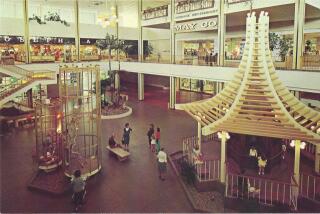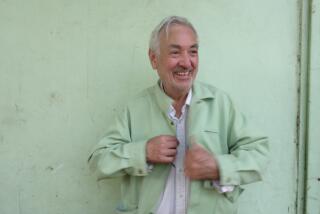Shopping Center Architect : Ronald Cleveland; Master Builder of Model Ships
- Share via
Ronald Cleveland, an architect who built mammoth shopping centers but whose more lasting legacy may be the handful of meticulously detailed models of old barkentines and barges he constructed throughout his lifetime, has died.
The master model-ship builder died in Irvine where he and his wife moved from their Beverly Hills home after his retirement in 1985. He was 75 and had been battling cancer.
Cleveland, who died May 23, traced his fascination with ships to his boyhood on Washington’s seacoast. After graduating from the University of Washington, he attended Art Center School in Los Angeles, was licensed as an architect and worked as a sketch artist in the film industry.
He worked for famed designer Raymond Loewy for four years and then, in 1947, formed his own architectural firm. Later, he and Sterling Leach became partners in Leach, Cleveland & Associates.
Supermarkets, Shopping Centers
Between them they planned and designed more than 100 supermarkets in and around Los Angeles, built the Pomona Valley Center and the Buena Park Shopping Center and six J. W. Robinson’s stores.
Their other centers ranged from Honolulu to Salt Lake City.
As his architecture firm prospered, Cleveland began to make his lifelong romance with the world of wooden ships powered solely by square-rigged canvas sails bloom.
He converted a spare bathroom in his home into a library where 700 volumes devoted to ships and sailing were stored. Many had been published in the 1700s. He filled his garage with the exotic and rare woods needed for his miniature armada and the precision tools required to build the ships.
He traveled the world doing research and spent 15 years corresponding with an old salt who had once commanded a sister ship of the barkentine Kohala which Cleveland was replicating in his home.
When the old sailor, Capt. Fred Klebingat, then 94, saw the finished product in 1984, he allowed that “if I could shrink my body to one-inch size, I could walk up the gangway, go to the wheel house and sail her out to sea.”
Kohala in San Francisco
The miniature Kohala never made it to sea but rests instead at the Maritime Museum in San Francisco after Cleveland declined a similar acceptance offer from the Smithsonian Institution in order to keep the miniature on the West Coast.
He spent weeks in London and then took four years to duplicate the spritsail barge Kathleen, a flat-bottomed sailing ship which once plied England’s Thames River. That model, where miniature helms actually move tiny rudders and winches barely visible to the naked eye up and down, was donated to Great Britain’s National Maritime Museum in Greenwich.
All his vessels were labors of love; he turned down many offers to sell them.
Cleveland, who spent countless thousands of dollars in travel and research and countless more hours actually planking dowels onto the frames of his tiny fleet as shipbuilding was done long ago, was never interested in changing the time concept of his avocation.
“For me, the big slab-sided buckets carrying oil (today) are no longer things of beauty,” he said in a 1972 interview with The Times.
“What I’ve attempted to do is show the great influence ships have had upon the happenings of mankind beginning at 10,000 BC through the dawn of the 20th Century.
Cleveland is survived by his wife, Jo Dee, two sons, a daughter and two grandchildren who ask donations in his name to the American Cancer Society.
More to Read
Sign up for Essential California
The most important California stories and recommendations in your inbox every morning.
You may occasionally receive promotional content from the Los Angeles Times.













